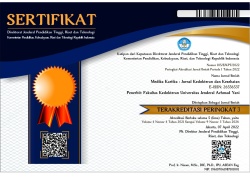HUBUNGAN PEMAKAIAN KONTRASEPSI HORMONAL TERHADAP KUANTITAS TEAR FILM
Abstract
Mata kering adalah penyakit multifaktorial yang ditandai dengan hilangnya homeostasis tear
film yang diikuti gejala okular akibat penurunan kuantitas tear film. Pada jaringan mata,
hormon seksual berperan dalam mengatur struktur dan fungsi dari kelenjar lakrimal.
Penggunaan kontrasepsi hormonal merupakan salah satu terapi sistemik yang dapat
dihubungkan dengan penurunan kuantitas tear film. Penelitian ini merupakan penelitian
analitik dengan pendekatan observasional pada 40 orang wanita dengan rentang usia 21-44
tahun. Kelompok sampel adalah wanita yang menggunakan kontrasepsi hormonal minimal
dalam 1 tahun dan kelompok kontrol adalah kelompok yang tidak menggunakan kontrasepsi
hormonal. Hasil penelitian dan analisis data mendapatkan rerata uji Schirmer kelompok
sampel dan kontrol adalah (21,3±12,7) dan (23,9±10). Rerata terkecil uji Schirmer adalah
pada kontrasepsi jenis injeksi 3 bulan, yaitu (18,2 ± 11,6). Pada tear meniscus terjadi
penurunan pada kelompok sampel (40%) dan kontrol (30%). Hasil kuesioner ocular surface
disease index (OSDI) kelompok sampel didapatkan dry eye ringan (20%), sedang (20%), dan
berat (5%). Sementara itu kelompok kontrol hanya mengalami dry eye ringan (45%). Dalam
penelitian ini menunjukkan tidak terdapat perbedaan hasil yang bermakna (p > 0,05) antara
kelompok tersebut. Kesimpulan yang didapatkan adalah tidak terdapat hubungan yang
bermakna pemakaian kontrasepsi hormonal dengan kuantitas tear film.
References
2. Septivanti R, Triningrat AAMP. Karakteristik pasien dry eye syndrome di Desa Tianyar. DOAJ. 2018 : 113-116.
3. Stapleton F, Alves M, Bunya VY, Jalbert I, Lekhanont K, Malet F, et al. TFOS DEWS II Epidemiology Report. Ocular Surface. 2017;15(3):334-365.
4. Sullivan DA, Rocha EM, Aragona P, Clayton JA, Ding J, Golebiowski, et al. TFOS DEWS II Sex, Gender, and Hormones Report. The Ocular Surface. 2017;15(3):284-333.
5. Truong S, Cole N, Stapleton F, Golebiowski B. Sex hormones and the dry eye. Clinical and Experimental Optometry. 2014;97(4):324-336.
6. Schaumberg DA, Buring JE, Sullivan DA, Reza Dana MR. Hormone replacement therapy and dry eye syndrome. JAMA. 2001;286(17):2114-2119.
7. Suzuki T, Sullivan DA. Estrogen Stimulation of Proinflammatory Cytokine and Matrix Metalloproteinase Gene Expression in Human Corneal Epithelial Cells. Cornea. 2005;24(8):1004-9.
8. Sharma A, Porwal S, Tyagi M. Effect of oral contraceptives on tear film in reproductive age group women. Int J Reprod Contraception, Obstet Gynecol. 2018;7(3):860.
9. Suzuki T, Schirra F, Richards SM, Richards SM, Treister NS, Lombardi MJ, et al. Estrogen’s and progesterone’s impact on gene expression in the mouse lacrimal gland. Investig Ophthalmol & Visual Science. 2006;47:158-68.
10. Bron AJ, de Paiva CS, Chauhan SK, Bonini S, Gabison EE, Jain S, et al. TFOS DEWS II pathophysiology report. The Ocular Surface. 2017;15:438-510.
11. Kemdinum IF, Emina MO, Ubaru CO. Tear secretion and tear stability of women on hormonal contraceptives. J Optom. 2013;6(1):45-50.
12. Colquitt CW, Martin TS. Contraceptive Methods: A Review of Nonbarrier and Barrier Products. J Pharm Pract. 2017;30(1):130-135.
13. Benagiano G, Gabelnick H, Brosens I. Long-acting Hormonal Contraception. Women's Heal ; 2015.
14. Bastianelli C, Farris M, Rosato E, Brosens I, Benagiano G. Pharmacodynamics of combined estrogen-progestin oral contraceptives 3. Inhibition of ovulation. Expert Rev Clin Pharmacol. 2018;11(11):1085-1098.
15. Zigler RE, McNicholas C. Unscheduled vaginal bleeding with progestin-only contraceptive use. Am J Obstet Gynecol. 2017;216(5):443-450.
16. Rivera R, Yacobson I, Grimes D. The mechanism of action of hormonal contraceptives and intrauterine contraceptive devices. Am J Obstet Gynecol. 1999;181(5 I):1263-1269.
17. Saif MYS, Sayed MA, Saif ATS. Effect of hormonal contraception on lacrimal gland function. Int Eye Sci. 2016;16(7):1207-1211.
18. Tomlinson A, Pearce EI, Simmons PA, Blades K. Effect of oral contraceptives on tear physiology.
19 Kojima T, Ibrahim OMA, Wakamatsu T, Tsuyama A, Ogawa J, Matsumoto Y et al. The impact of contact lens wear and visual display terminal work on ocular surface and tear functions in office workers. Am J Ophthalmol. 2011;152(6):933-940.e2.
20. Larasati AW, Himayani R. Hubungan Penggunaan Air Conditioner (AC) di Ruang Kelas Terhadap Kejadian Sindrom Mata Kering Pada Pelajar SMA Negeri Bandar Lampung Correlation Between Using Air Conditioner In Classroom and The Incident of Dry Eye Syndrome in Senior High School at Ban. J Major. 2020;9(1):35-39.
21. Nichols KK, Nichols JJ, Mitchell GL. The lack of association between signs and symptoms in patients with dry eye disease. Cornea. 2004;23(8):762-770.
22. Ranjan R, Shukla SK, Veer Singh C, Mishra BN, Sinha S, Sharma BD. Prevalence of Dry Eye and Its Association with Various Risk Factors in Rural Setup of Western Uttar Pradesh in a Tertiary Care Hospital. Open J Prev Med. 2016;06(01):57-63. 4
23. Chen SP, Massaro-Giordano G, Pistilli M, Schreiber CA, Bunya VY. Tear osmolarity and dry eye symptoms in women using oral contraception and contact lenses. Cornea. 2013;32(4):423-428.




























